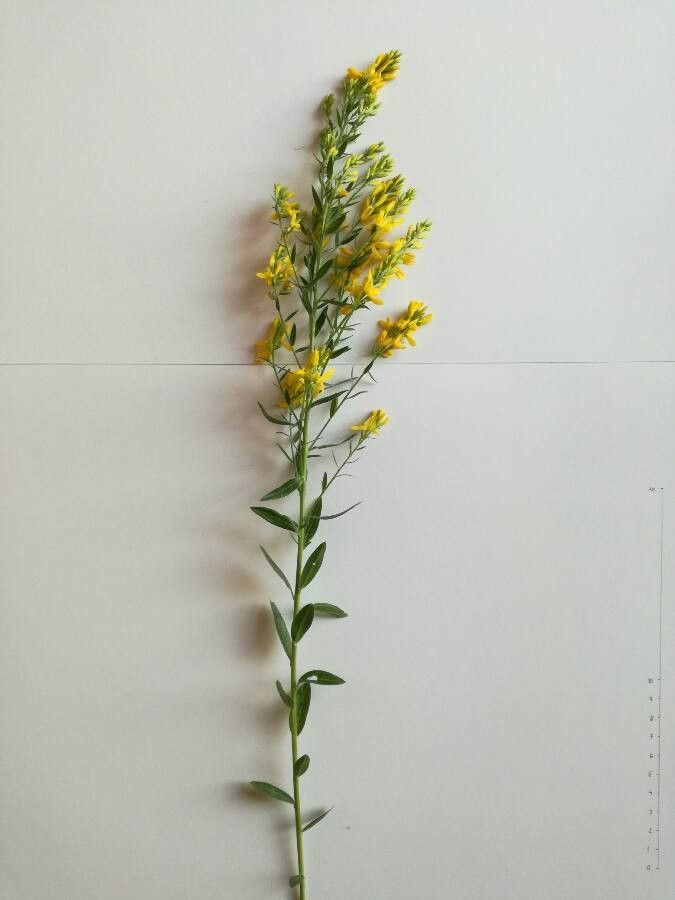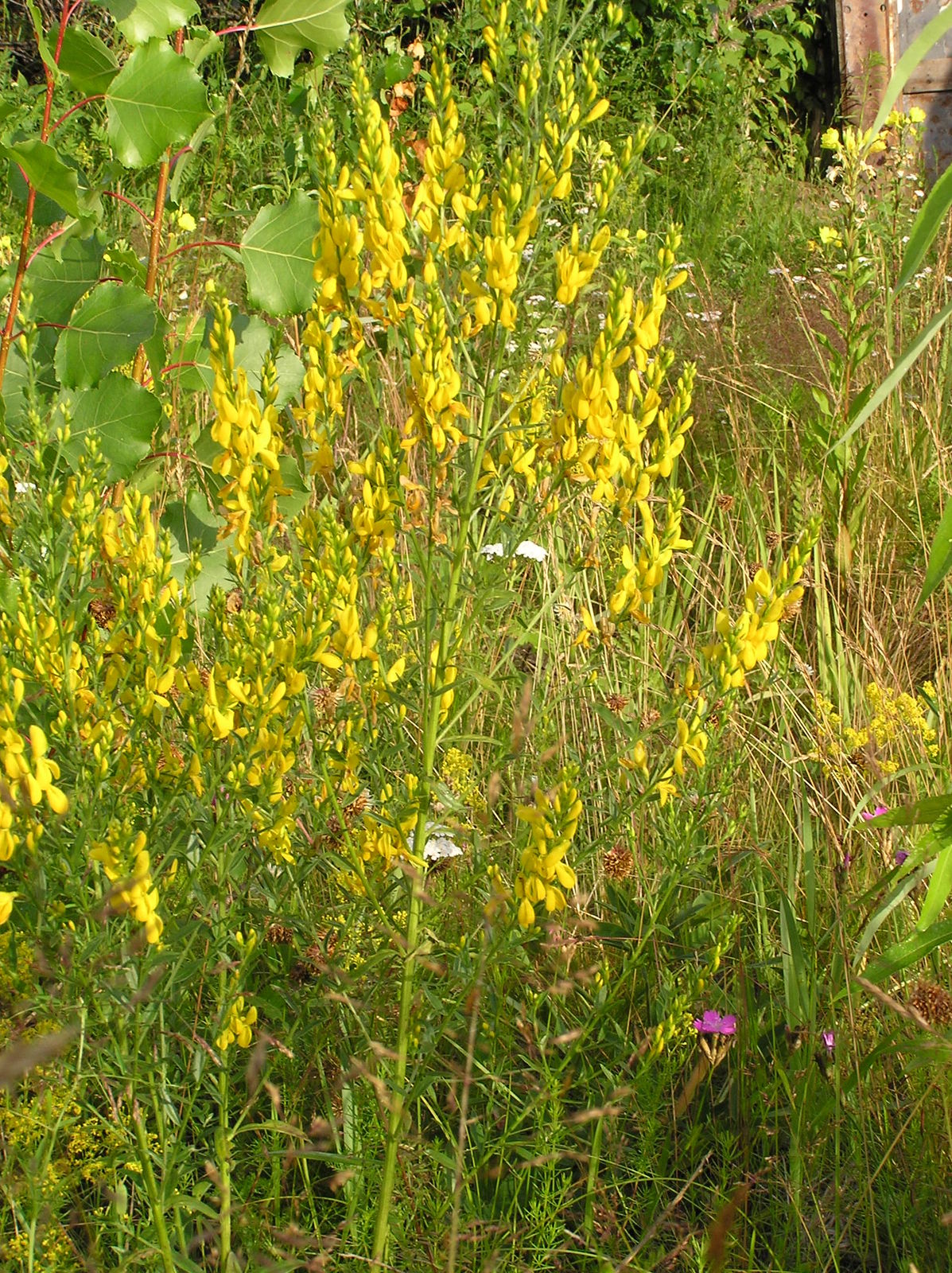Dyer's Greenweed
genista tinctoria
Also known as: ["Dyer's Broom","Dyer's Weed"]
Overview
A deciduous shrub native to Europe and Asia, valued for its yellow flowers and historical use in dye production.
Benefits & Perks
["long-flowering","wildlife attractant (bees, butterflies, birds)","drought tolerant"]
Botanical Classification
| Phylum: | Magnoliophyta |
| Class: | Magnoliopsida |
| Order: | Fabales |
| Family: | Fabaceae |
| Genus: | Genista |
| Botanical Name: | Genista tinctoria |
Plant Characteristics
Basic Information
- Category: Shrubs
- Suitable Location: border plantings, rock gardens, or open meadows
- Suitable For:
- Is Weed: No
- Allergenicity: low
Environmental Needs
- Climate: {"temperatureRange":"–30–30°C"}
- Hardiness: {"zones":"3–7"}
- Misting: rarely required, only if ambient humidity is very low
- Drainage: Fast-draining to prevent waterlogging.
- Soil Type: Well-draining, sandy, or loamy soil with some organic matter.
Maintenance Level
- Maintenance Level: moderate
- Toughness Level: moderate
- Pruning Frequency: Annually, after flowering in late spring or early summer.
- Pruning Intensity: Moderate, focusing on shaping and removing old wood.
Care Details
Ideal Sunlight Coverage:
Full sun (6–8 hours of direct sunlight daily) is ideal, though it can tolerate partial shade, especially in hot climates.
Sunlight Tolerance Tips:
Acclimate plants gradually to intense sunlight to prevent scorching; provide afternoon shade in hot regions; ensure proper air circulation to prevent fungal issues.
Care Requirements
Care Difficulty
moderatemoderate
Sunlight
full sun to partial shade
Avoid sudden light changes; protect from harsh afternoon sun in summer; rotate plants for even growth.
Watering
every 7–10 days during active growth, reduce in winter
Water deeply but infrequently to encourage deep root growth; ensure proper drainage to avoid waterlogging; adjust frequency based on season and weather conditions.
Soil
well-drained, sandy or loamy soil
pH: Slightly acidic to neutral (pH 6.0–7.0).
Ensure excellent drainage; avoid heavy clay soils; amend with organic matter if needed.
Temperature
Prefers cool to moderate temperatures (60–75°F or 15–24°C). Can tolerate cold down to -30°F (-34°C) but thrives in cooler conditions.
Protect from extreme heat; ensure good air circulation; adjust watering for temperature changes.
Fertilizing
every 4–6 weeks during spring and summer
Fertilize sparingly; apply in spring only; use a balanced formula to avoid nutrient imbalances.
Propagation
Methods
Stem cuttings taken in late spring or early summer.
Step-by-Step Propagation Guide
- Take 4–6 inch cuttings.
- Remove lower leaves.
- Dip in rooting hormone.
- Plant in medium.
- Keep moist and warm.
Best Time: Late spring to early summer when the plant is actively growing.
Environment
Warm, humid environment with indirect light and consistent moisture.
Medium
Well-draining potting mix, such as a mix of peat and perlite or sand.
Hormone
Rooting hormone is recommended to improve rooting success.
Timeline
Roots typically develop in 4–8 weeks; plants can be transplanted after a few months.
Tools Needed
Pruning shears, rooting hormone, small pots, well-draining medium.
Quick Tips
Use healthy, non-flowering stems; maintain humidity around cuttings; avoid direct sunlight.
Pruning & Repotting
Pruning Guide
Method
Selective pruning of branches to maintain form and promote airflow.
Pruning Plan
Prune to maintain shape, encourage bushiness, and remove dead or weak growth.
Tools
Pruning shears, loppers (for larger branches), gloves.
Checklist
Use clean tools; prune after flowering; remove dead or crossing branches; shape the plant.
Repotting Guide
Best Season
Early spring before new growth begins.
Pot Size
One size larger pot (e.g., +2–3 inches in diameter).
Method
Gently remove the plant, trim any circling roots, and repot in fresh, well-draining soil with a slightly larger pot.
Suggestions
Repot only when necessary, typically every 2–3 years or if the plant becomes root-bound.
Checklist
Choose appropriate pot size; use fresh soil mix; trim roots if needed; water after repotting.
Advanced Care Tips
Watering Mastery
Watering Checklist
Check soil moisture before watering; water deeply at the base; ensure drainage; adjust for season.
How to Apply Water Properly
Water at the base of the plant, targeting the root zone to avoid wetting foliage. Apply water slowly and deeply until it begins to drain from the bottom, ensuring even moisture distribution.
Watering Schedule Tips
Water moderately during active growth in spring and summer, allowing the top inch of soil to dry between waterings. Reduce watering significantly in fall and winter to prevent root rot.
Soil Improvement
Add sand or perlite to improve drainage; incorporate compost for organic matter; ensure good aeration.
Temperature Stress Management
Signs of Temperature Issues
Wilting, leaf drop, or browning foliage in excessive heat; stunted growth or yellowing leaves in overly cold conditions.
Cold Stress
Cold stress can slow growth and cause leaf discoloration, but the plant is generally hardy and can withstand freezing temperatures.
Solution: Ensure good air circulation; avoid overwatering in cold weather; protect from harsh winds and frost if grown in containers.
Hot Stress
Excessive heat can cause wilting, leaf scorch, and reduced flowering.
Solution: Provide afternoon shade; increase watering during heatwaves; mulch to retain soil moisture.
Fertilizing Guide
Fertilizing Checklist
Use balanced fertilizer; apply in spring; avoid over-fertilizing; water after application.
Fertilizing Method
Use a balanced, slow-release fertilizer in early spring before new growth begins. Avoid over-fertilizing, as Genista tinctoria is not heavy feeder.
Common Problems & Solutions
Toxicity Warning
Cats
Slightly ToxicCats may experience mild gastrointestinal symptoms if they ingest the seeds or roots of Genista tinctoria. While not highly toxic, ingestion should be prevented to avoid potential discomfort.
⚠️ Symptoms:
🌿 Toxic Parts:
⚡ Toxic If:
if eaten
Dogs
Slightly ToxicIn dogs, ingestion of Genista tinctoria seeds and roots may lead to mild gastrointestinal upset. The plant is not considered highly toxic, but ingestion should be avoided to prevent discomfort.
⚠️ Symptoms:
🌿 Toxic Parts:
⚡ Toxic If:
if eaten
Humans
Slightly ToxicGenista tinctoria contains toxic compounds, primarily in its seeds and roots, which can cause mild gastrointestinal distress and other mild symptoms upon ingestion. The plant is not typically considered highly toxic to humans, but caution is advised.
⚠️ Symptoms:
🌿 Toxic Parts:
⚡ Toxic If:
if eaten
Frequently Asked Questions
Q: Is Genista tinctoria toxic to pets?
A: Reliable information on toxicity to pets is not available.
Q: How often should Genista tinctoria be watered?
A: Water moderately, allowing the soil to dry slightly between waterings.
Q: Does Genista tinctoria attract wildlife?
A: Yes, it is known to attract bees, butterflies, and birds.
Quick Reference
| Family: | Fabaceae |
| Care: | moderate |
| Light: | full sun to partial shade |
| Water: | every 7–10 days during activ |
Get Expert Care Tips
Download the Plantious app for personalized care reminders and plant identification!
Google Play App Store








